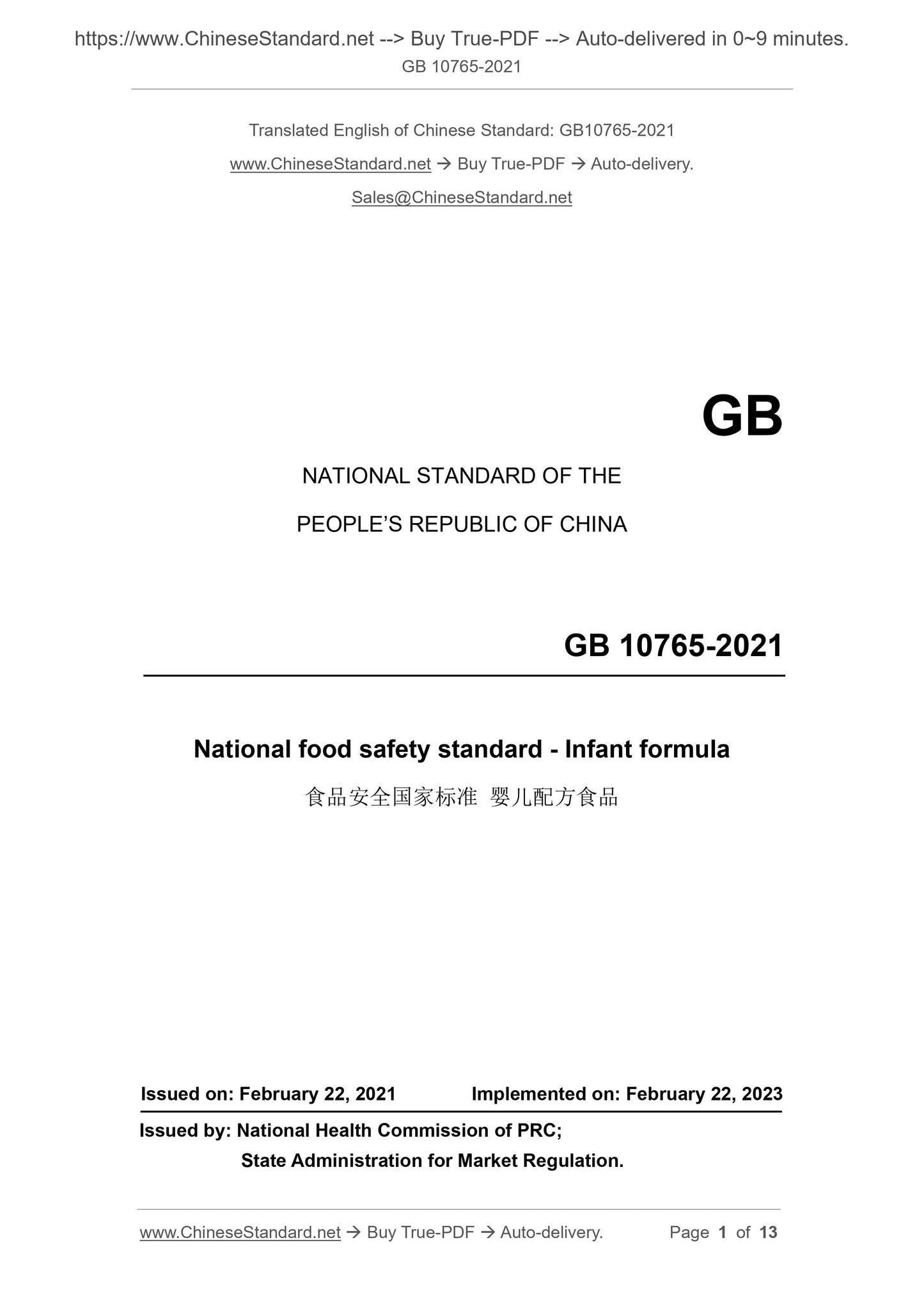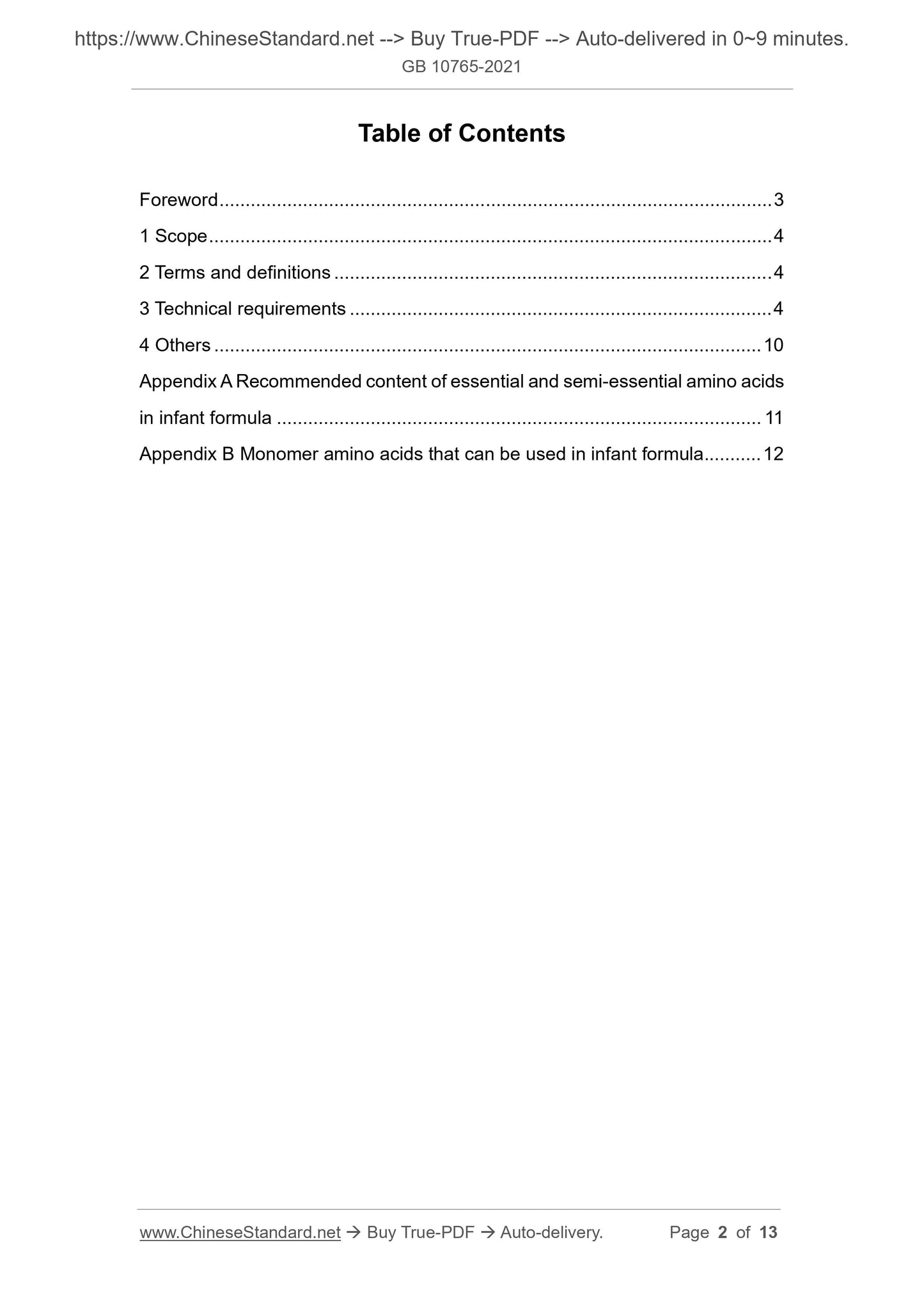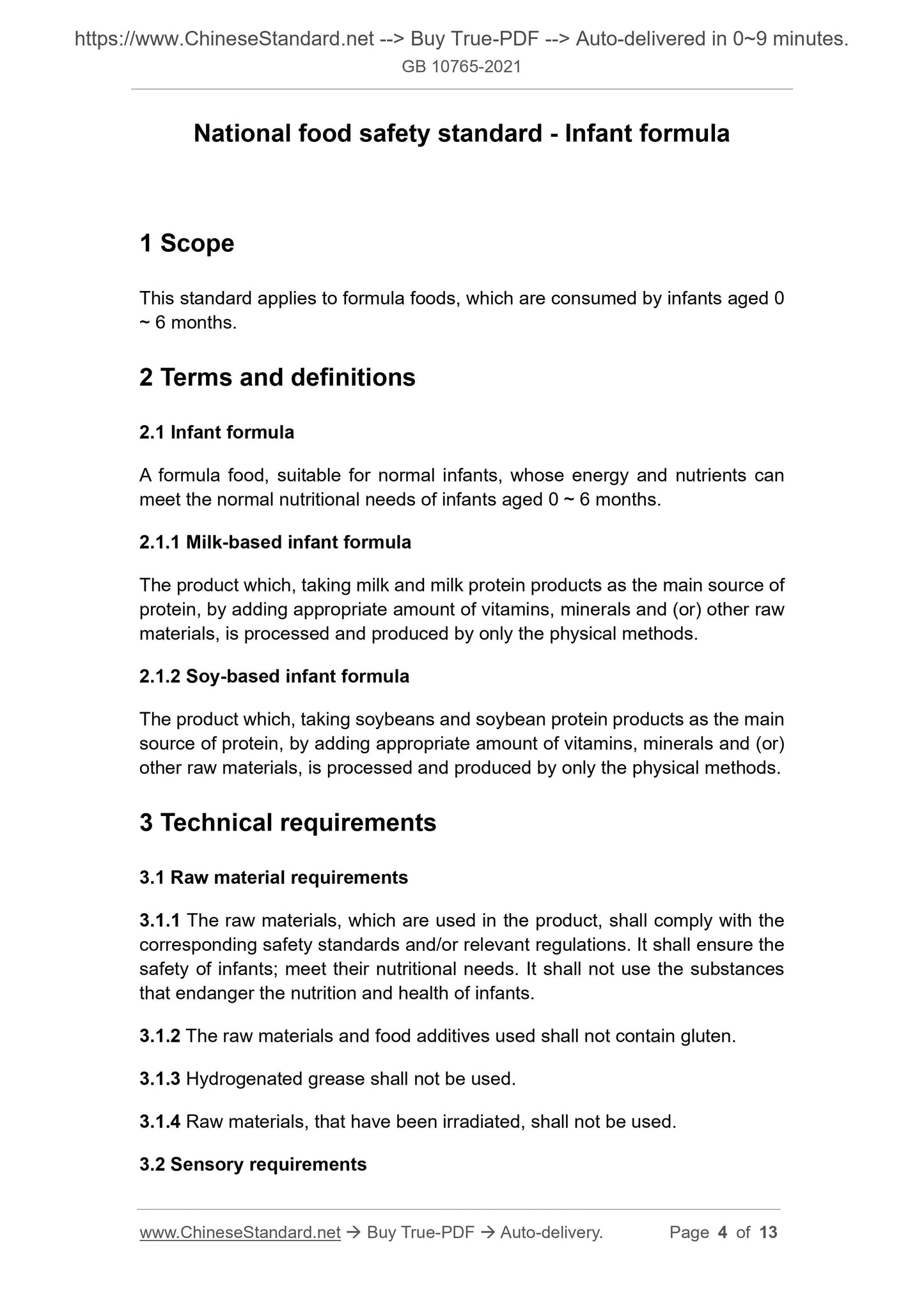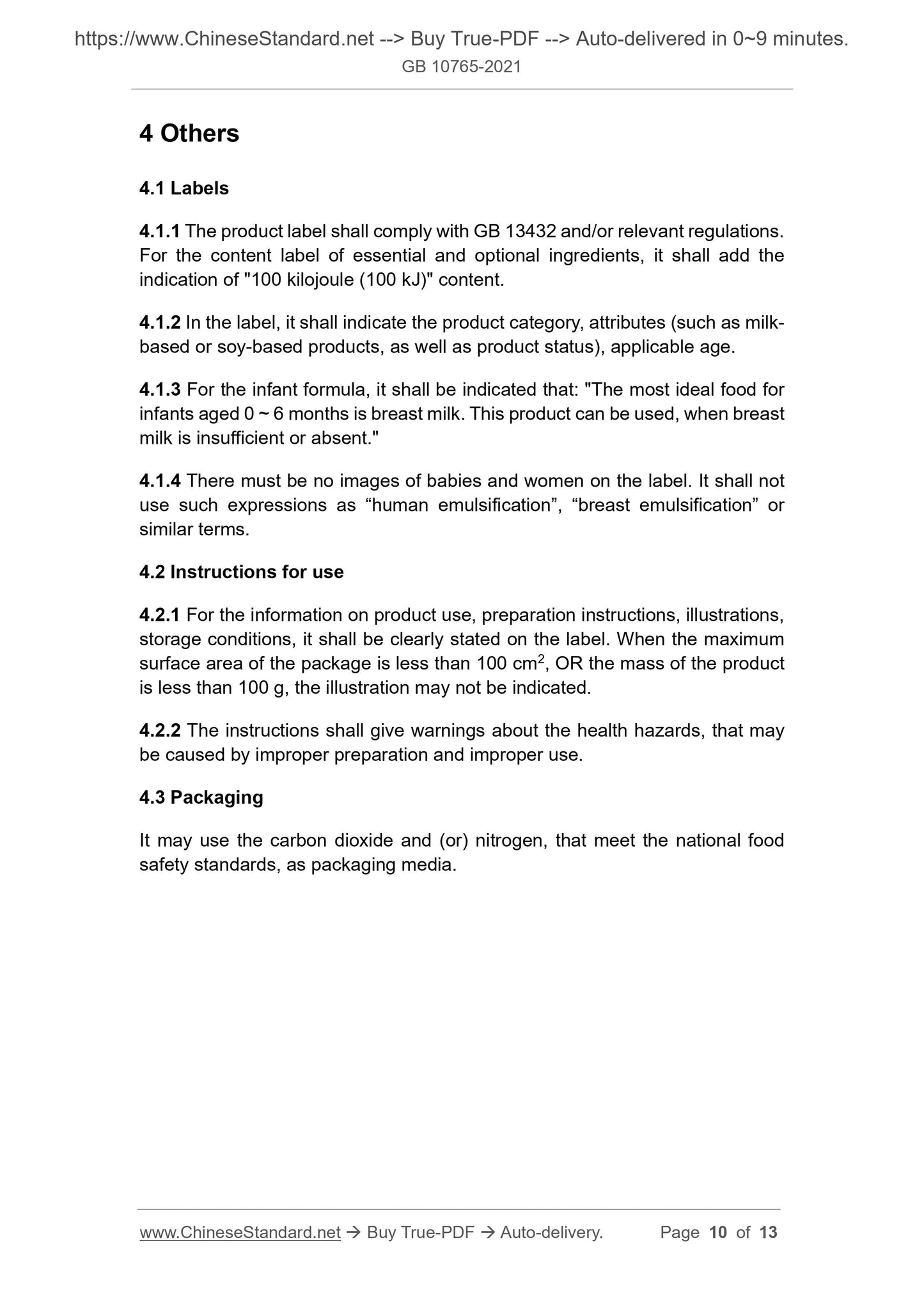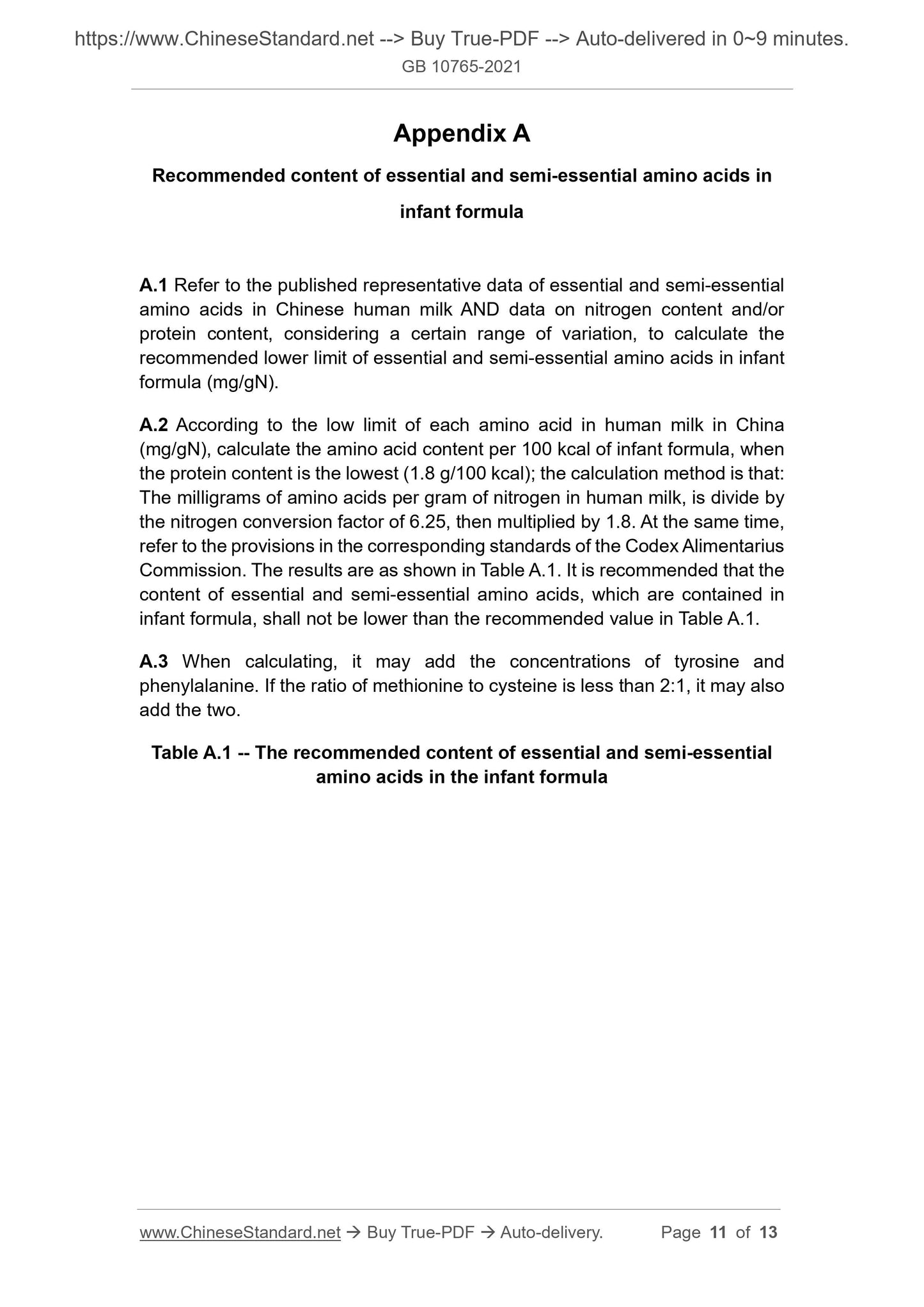1
/
su
5
PayPal, credit cards. Download editable-PDF & invoice in 1 second!
GB 10765-2021 English PDF (GB10765-2021)
GB 10765-2021 English PDF (GB10765-2021)
Prezzo di listino
$155.00 USD
Prezzo di listino
Prezzo scontato
$155.00 USD
Prezzo unitario
/
per
Spese di spedizione calcolate al check-out.
Impossibile caricare la disponibilità di ritiro
Delivery: 3 seconds. Download true-PDF + Invoice.
Get QUOTATION in 1-minute: Click GB 10765-2021
Historical versions: GB 10765-2021
Preview True-PDF (Reload/Scroll if blank)
GB 10765-2021: National food safety standard - Infant Formula
GB 10765-2021
GB
NATIONAL STANDARD OF THE
PEOPLE’S REPUBLIC OF CHINA
National food safety standard - Infant formula
ISSUED ON: FEBRUARY 22, 2021
IMPLEMENTED ON: FEBRUARY 22, 2023
Issued by: National Health Commission of PRC;
State Administration for Market Regulation.
Table of Contents
Foreword ... 3
1 Scope ... 4
2 Terms and definitions ... 4
3 Technical requirements ... 4
4 Others ... 10
Appendix A Recommended content of essential and semi-essential amino acids
in infant formula ... 11
Appendix B Monomer amino acids that can be used in infant formula ... 12
National food safety standard - Infant formula
1 Scope
This standard applies to formula foods, which are consumed by infants aged 0
~ 6 months.
2 Terms and definitions
2.1 Infant formula
A formula food, suitable for normal infants, whose energy and nutrients can
meet the normal nutritional needs of infants aged 0 ~ 6 months.
2.1.1 Milk-based infant formula
The product which, taking milk and milk protein products as the main source of
protein, by adding appropriate amount of vitamins, minerals and (or) other raw
materials, is processed and produced by only the physical methods.
2.1.2 Soy-based infant formula
The product which, taking soybeans and soybean protein products as the main
source of protein, by adding appropriate amount of vitamins, minerals and (or)
other raw materials, is processed and produced by only the physical methods.
3 Technical requirements
3.1 Raw material requirements
3.1.1 The raw materials, which are used in the product, shall comply with the
corresponding safety standards and/or relevant regulations. It shall ensure the
safety of infants; meet their nutritional needs. It shall not use the substances
that endanger the nutrition and health of infants.
3.1.2 The raw materials and food additives used shall not contain gluten.
3.1.3 Hydrogenated grease shall not be used.
3.1.4 Raw materials, that have been irradiated, shall not be used.
3.2 Sensory requirements
4 Others
4.1 Labels
4.1.1 The product label shall comply with GB 13432 and/or relevant regulations.
For the content label of essential and optional ingredients, it shall add the
indication of "100 kilojoule (100 kJ)" content.
4.1.2 In the label, it shall indicate the product category, attributes (such as milk-
based or soy-based products, as well as product status), applicable age.
4.1.3 For the infant formula, it shall be indicated that: "The most ideal food for
infants aged 0 ~ 6 months is breast milk. This product can be used, when breast
milk is insufficient or absent."
4.1.4 There must be no images of babies and women on the label. It shall not
use such expressions as “human emulsification”, “breast emulsification” or
similar terms.
4.2 Instructions for use
4.2.1 For the information on product use, preparation instructions, illustrations,
storage conditions, it shall be clearly stated on the label. When the maximum
surface area of the package is less than 100 cm2, OR the mass of the product
is less than 100 g, the illustration may not be indicated.
4.2.2 The instructions shall give warnings about the health hazards, that may
be caused by improper preparation and improper use.
4.3 Packaging
It may use the carbon dioxide and (or) nitrogen, that meet the national food
safety standards, as packaging media.
Appendix A
Recommended content of essential and semi-essential amino acids in
infant formula
A.1 Refer to the published representative data of essential and semi-essential
amino acids in Chinese human milk AND data on nitrogen content and/or
protein content, considering a certain range of variation, to calculate the
recommended lower limit of essential and semi-essential amino acids in infant
formula (mg/gN).
A.2 According to the low limit of each amino acid in human milk in China
(mg/gN), calculate the amino acid content per 100 kcal of infant formula, when
the protein content is the lowest (1.8 g/100 kcal); the calculation method is that:
The milligrams of amino acids per gram of nitrogen in human milk, is divide by
the nitrogen conversion factor of 6.25, then multiplied by 1.8. At the same time,
refer to the provisions in the corresponding standards of the Codex Alimentarius
Commission. The results are as shown in Table A.1. It is recommended that the
content of essential and semi-essential amino acids, which are contained in
infant formula, shall not be lower than the recommended value in Table A.1.
A.3 When calculating, it may add the concentrations of tyrosine and
phenylalanine. If the ratio of methionine to cysteine is less than 2:1, it may also
add the two.
Table A.1 -- The recommended content of essential and semi-essential
amino acids in the infant formula
Get QUOTATION in 1-minute: Click GB 10765-2021
Historical versions: GB 10765-2021
Preview True-PDF (Reload/Scroll if blank)
GB 10765-2021: National food safety standard - Infant Formula
GB 10765-2021
GB
NATIONAL STANDARD OF THE
PEOPLE’S REPUBLIC OF CHINA
National food safety standard - Infant formula
ISSUED ON: FEBRUARY 22, 2021
IMPLEMENTED ON: FEBRUARY 22, 2023
Issued by: National Health Commission of PRC;
State Administration for Market Regulation.
Table of Contents
Foreword ... 3
1 Scope ... 4
2 Terms and definitions ... 4
3 Technical requirements ... 4
4 Others ... 10
Appendix A Recommended content of essential and semi-essential amino acids
in infant formula ... 11
Appendix B Monomer amino acids that can be used in infant formula ... 12
National food safety standard - Infant formula
1 Scope
This standard applies to formula foods, which are consumed by infants aged 0
~ 6 months.
2 Terms and definitions
2.1 Infant formula
A formula food, suitable for normal infants, whose energy and nutrients can
meet the normal nutritional needs of infants aged 0 ~ 6 months.
2.1.1 Milk-based infant formula
The product which, taking milk and milk protein products as the main source of
protein, by adding appropriate amount of vitamins, minerals and (or) other raw
materials, is processed and produced by only the physical methods.
2.1.2 Soy-based infant formula
The product which, taking soybeans and soybean protein products as the main
source of protein, by adding appropriate amount of vitamins, minerals and (or)
other raw materials, is processed and produced by only the physical methods.
3 Technical requirements
3.1 Raw material requirements
3.1.1 The raw materials, which are used in the product, shall comply with the
corresponding safety standards and/or relevant regulations. It shall ensure the
safety of infants; meet their nutritional needs. It shall not use the substances
that endanger the nutrition and health of infants.
3.1.2 The raw materials and food additives used shall not contain gluten.
3.1.3 Hydrogenated grease shall not be used.
3.1.4 Raw materials, that have been irradiated, shall not be used.
3.2 Sensory requirements
4 Others
4.1 Labels
4.1.1 The product label shall comply with GB 13432 and/or relevant regulations.
For the content label of essential and optional ingredients, it shall add the
indication of "100 kilojoule (100 kJ)" content.
4.1.2 In the label, it shall indicate the product category, attributes (such as milk-
based or soy-based products, as well as product status), applicable age.
4.1.3 For the infant formula, it shall be indicated that: "The most ideal food for
infants aged 0 ~ 6 months is breast milk. This product can be used, when breast
milk is insufficient or absent."
4.1.4 There must be no images of babies and women on the label. It shall not
use such expressions as “human emulsification”, “breast emulsification” or
similar terms.
4.2 Instructions for use
4.2.1 For the information on product use, preparation instructions, illustrations,
storage conditions, it shall be clearly stated on the label. When the maximum
surface area of the package is less than 100 cm2, OR the mass of the product
is less than 100 g, the illustration may not be indicated.
4.2.2 The instructions shall give warnings about the health hazards, that may
be caused by improper preparation and improper use.
4.3 Packaging
It may use the carbon dioxide and (or) nitrogen, that meet the national food
safety standards, as packaging media.
Appendix A
Recommended content of essential and semi-essential amino acids in
infant formula
A.1 Refer to the published representative data of essential and semi-essential
amino acids in Chinese human milk AND data on nitrogen content and/or
protein content, considering a certain range of variation, to calculate the
recommended lower limit of essential and semi-essential amino acids in infant
formula (mg/gN).
A.2 According to the low limit of each amino acid in human milk in China
(mg/gN), calculate the amino acid content per 100 kcal of infant formula, when
the protein content is the lowest (1.8 g/100 kcal); the calculation method is that:
The milligrams of amino acids per gram of nitrogen in human milk, is divide by
the nitrogen conversion factor of 6.25, then multiplied by 1.8. At the same time,
refer to the provisions in the corresponding standards of the Codex Alimentarius
Commission. The results are as shown in Table A.1. It is recommended that the
content of essential and semi-essential amino acids, which are contained in
infant formula, shall not be lower than the recommended value in Table A.1.
A.3 When calculating, it may add the concentrations of tyrosine and
phenylalanine. If the ratio of methionine to cysteine is less than 2:1, it may also
add the two.
Table A.1 -- The recommended content of essential and semi-essential
amino acids in the infant formula
Share
